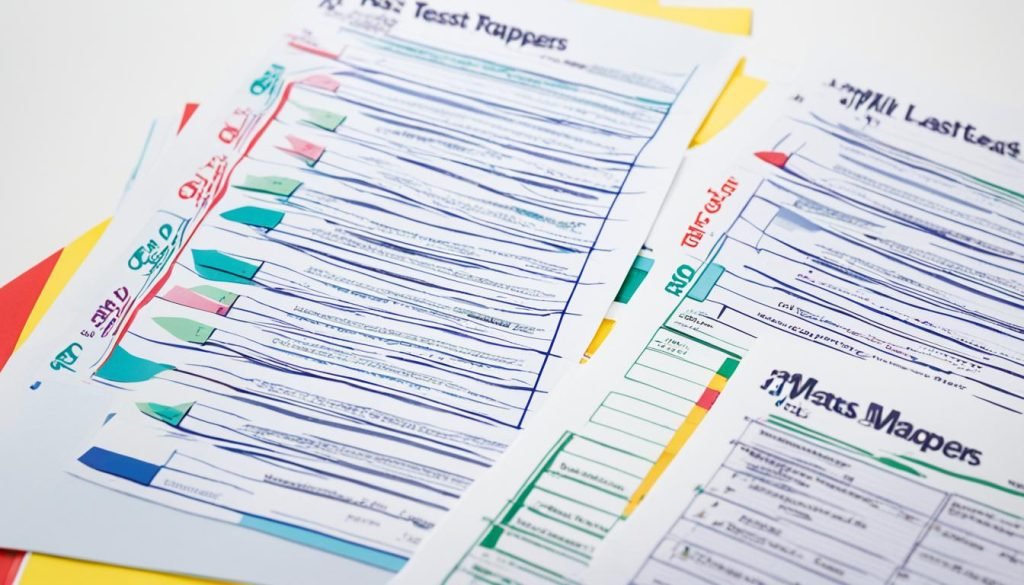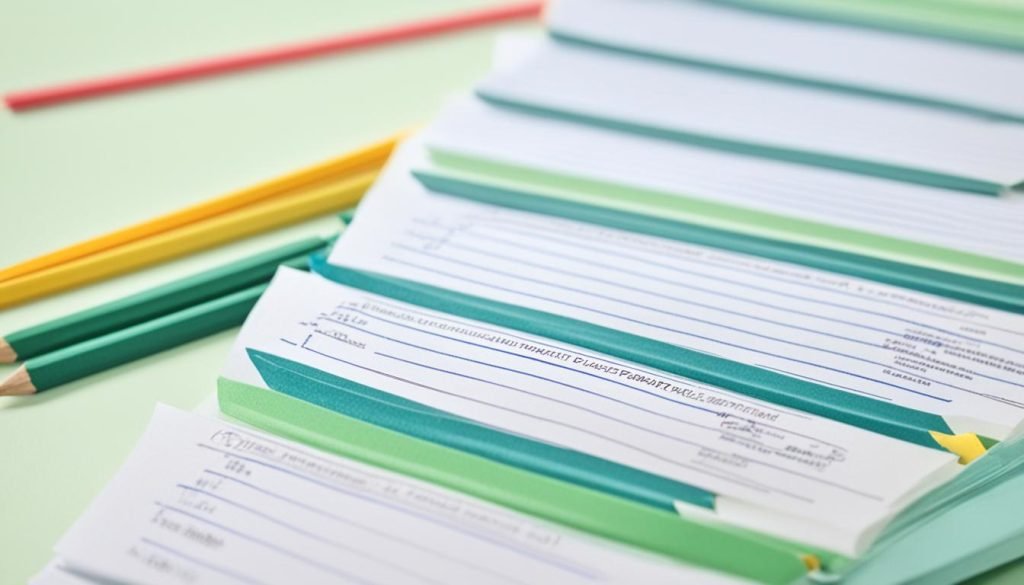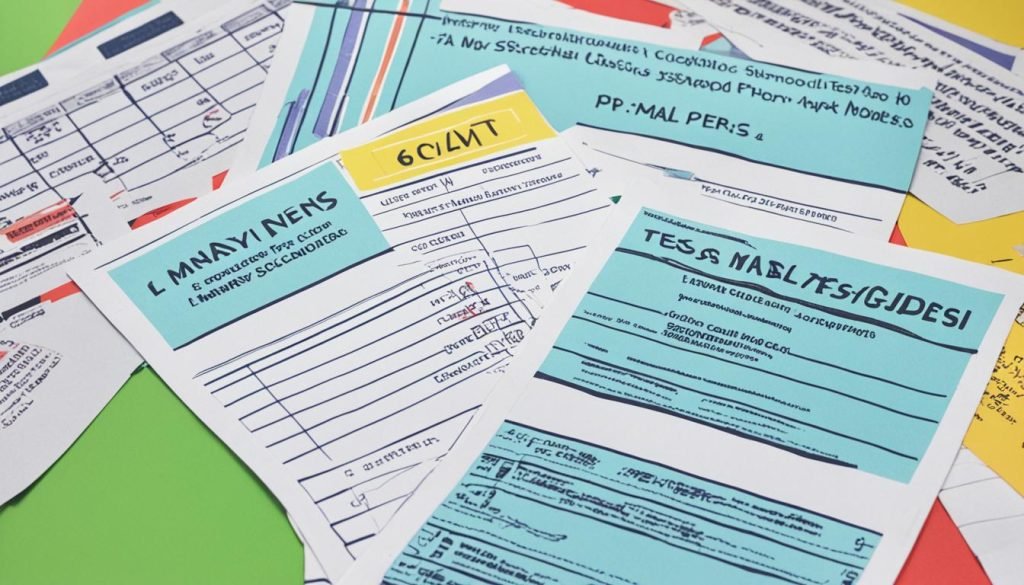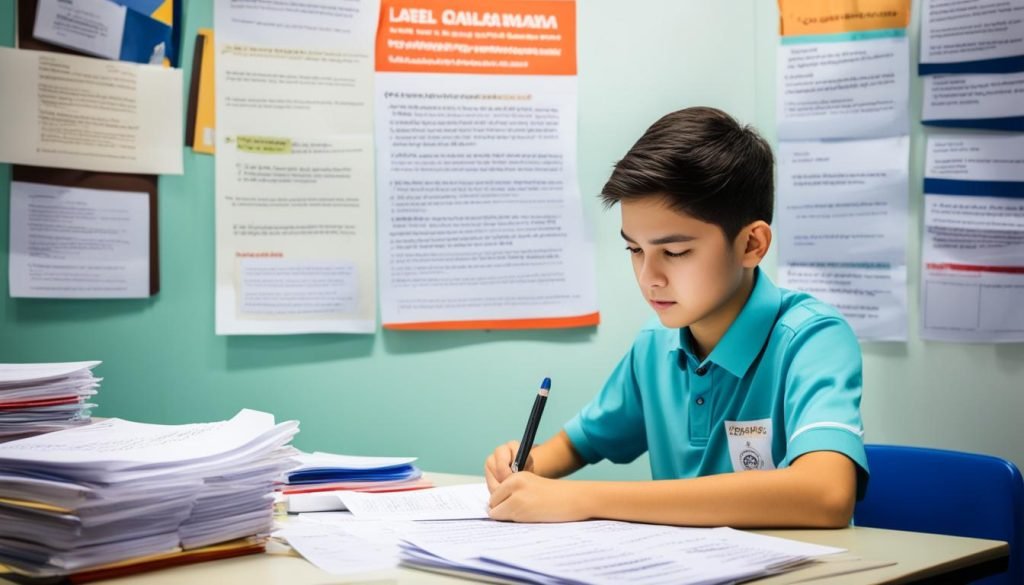Students getting ready for the Primary School Leaving Examination (PSLE) in Singapore need good Malay practice materials. This article offers a bunch of free Primary 6 (P6) Malay test papers. You can download these to help your child get better at Malay.
By using these past year Malay exam papers, students get used to the exam style. They can see what they’re good at and what they need to work on. This helps them do well in the PSLE Malay test.
If you’re a parent wanting to help your child with Malay, or a student wanting to prepare on your own, these free Malay test papers are perfect for you. They will be a big help on your path to success. Start using these resources and see your child’s Malay skills improve a lot.

Key Takeaways
- Access a vast collection of free P6 Malay test papers for comprehensive practice
- Familiarize yourself with the exam format and identify areas for improvement
- Develop effective strategies to excel in the PSLE Malay assessment
- Support your child’s Malay language learning with high-quality practice materials
- Witness your child’s Malay proficiency and confidence reach new heights
Introduction to Primary 6 Malay Test Papers
Primary 6 students in Singapore are getting ready for the big PSLE Malay exam. Practicing with past year primary 6 Malay test papers is key. These papers help students get used to the exam’s format and what’s tested.
Importance of Practicing with Past Year Papers
Getting to know the structure and types of questions in past year p6 Malay practice papers is crucial. Students learn about the Malay language test and find out where they need to improve. They practice grammar, vocabulary, reading, and writing.
Overview of Malay Language Examinations in Primary 6
The Malay test in Primary 6 has two parts: Continual Assessments (CA1 and CA2) and Semestral Assessments (SA1 and SA2). These tests check how well students can read, answer questions, and use grammar and vocabulary.
| Assessment | Description | Weightage |
|---|---|---|
| Continual Assessments (CA1 and CA2) | Ongoing assessments that take place throughout the academic year | 20% of overall Malay language grade |
| Semestral Assessments (SA1 and SA2) | Comprehensive examinations conducted at the end of each semester | 80% of overall Malay language grade |
Knowing about these assessments helps students plan their Malay study. This way, they can do well in their PSLE Malay exam.
Types of Primary 6 Malay Test Papers Available
Primary 6 students in Singapore get ready for Malay language tests. They face two main types: Continual Assessments (CA1 and CA2) and Semestral Assessments (SA1 and SA2). These tests check skills like reading, grammar, vocabulary, and writing in Malay.
Continual Assessments (CA1 and CA2)
Continual Assessments, or CAs, happen at the end of each term. They focus on what students learned about Malay language during that term. CA1 and CA2 track students’ progress and spot areas that need more help.
Semestral Assessments (SA1 and SA2)
Semestral Assessments, or SAs, are at the end of each semester. They test how well students know Malay language overall. SA1 and SA2 are key tests that show if students are ready for the PSLE Malay exam.
Knowing about p6 malay ca1 ca2 sa1 sa2, or primary 6 malay continual assessments and primary 6 malay semestral assessments, helps students. It helps them prepare for Malay language tests and do well.

“Practicing with past year test papers is crucial for building confidence and honing Malay language skills.”
Getting ready for the Primary 6 (P6) Malay exam? Using past year test papers from top schools is key. These schools in Singapore offer free downloads. They help students get used to the exam’s style and difficulty.
Top schools like Ai Tong School, Anglo-Chinese School (Primary), Anglo-Chinese Junior College, Nanyang Primary School, Raffles Girls’ Primary School, and Maris Stella High School are great for downloading P6 Malay test papers. They’re known for their strong Malay programs and students who do well in the PSLE Malay exam.
- Ai Tong School is a top school with a tough Malay course and great PSLE Malay scores.
- Anglo-Chinese School (Primary) and Anglo-Chinese Junior College offer lots of Malay language resources, including past year test papers.
- Nanyang Primary School focuses on bilingual education and has many Malay test papers for download.
- Raffles Girls’ Primary School is a top choice that produces great Malay language learners. Their test papers are very useful.
- Maris Stella High School is known for its Malay language education and has lots of test papers for P6 students.
Downloading these free P6 Malay test papers from top schools in Singapore helps students understand what the exam expects. It also improves their test-taking skills. This can lead to better results in the PSLE Malay exam.

“Practicing with past year test papers from leading schools is crucial for mastering the Malay language and excelling in the PSLE exam.”
Download Free Malay Test Papers P6
Parents and students can find free P6 Malay test papers online. These papers cover many topics and levels. They help students practice for their Malay language tests.
One great place to find these papers is TestPapersFree.com. It has lots of past year papers, like Continual Assessments and Semestral Assessments.
Another good site is TestPapersFree.com/p6. It has a special section for Primary 6 test papers in Malay. Students can download papers and practice at their own speed.
For more resources, like Malay exam papers for primary 6, check out Mendaki.org.sg. This site has past year papers, study guides, and more to help with Malay language.
| Test Paper Type | Subjects Covered | Year Range |
|---|---|---|
| Continuous Assessments (CA1 and CA2) | Malay, Math, Science, English, Chinese, Tamil | 2004 – 2023 |
| Semestral Assessments (SA1 and SA2) | Malay, Math, Science, English, Chinese, Tamil | 2004 – 2023 |
These free Malay test papers help Primary 6 students practice and get better at the language. They make students ready for the PSLE Malay exam.

“Practicing with past year papers is the key to mastering the Malay language and achieving success in the PSLE examinations.” – Malay Language Teacher, XYZ Primary School
By using these free Malay test papers, students get used to the exam format. They find out what they’re good at and what they need to work on. This helps them do well in Malay language tests.
Preparation Strategies for the PSLE Malay Examination
To do well in the PSLE Malay exam, students need a solid plan. First, they should know the exam’s format and what questions are asked. This helps them use their time and resources wisely.
Understanding the Examination Format and Weightage
The PSLE Malay exam has different parts, each worth a certain amount. These parts include listening, reading, grammar, and writing. Knowing the exam’s layout and how marks are given lets students plan better.
Effective Revision Techniques
Using p6 malay test paper samples from past exams is key. It helps students get used to the types of questions and how fast they need to answer. Knowing what they’re good and not so good at helps them focus on improving.
- Regularly reviewing vocabulary and grammar concepts
- Practicing listening comprehension exercises
- Engaging in writing practice with feedback from teachers
- Participating in group discussions to improve speaking skills
These strategies help students get better at Malay and do well in the PSLE exam.

“Consistent practice and a thorough understanding of the exam format are the keys to excelling in the PSLE Malay examination.”
| Exam Component | Weightage |
|---|---|
| Listening Comprehension | 20% |
| Reading Comprehension | 30% |
| Grammar | 20% |
| Composition | 30% |
In Singapore, knowing Malay is very important. It’s one of the four official languages. Learning Malay well helps students do well in their PSLE tests. It also makes them better at thinking, talking, and understanding different cultures.
Benefits of Bilingualism in Singapore
Being bilingual in Malay and another language, like English, is great in Singapore’s diverse society. Here are some benefits:
- Cognitive Advantages: Bilingual people often solve problems better, remember more, and think more flexibly than those who speak only one language.
- Improved Communication: Knowing Malay and another language helps students talk better with different people. This leads to better understanding and working together.
- Cultural Awareness: Learning Malay lets students appreciate Singapore’s Malay culture more. It also helps them respect the country’s diverse people.
By focusing on Malay language skills, students in Singapore get many benefits. These benefits help them in school and their future careers.
“Bilingualism is a gift that keeps on giving. It’s a skill that empowers individuals to connect with diverse communities and gain a unique perspective on the world.”

| Benefit | Description |
|---|---|
| Cognitive Advantages | Bilingual individuals often exhibit enhanced problem-solving skills, improved memory, and greater mental flexibility. |
| Improved Communication | Proficiency in Malay and another language allows students to communicate more effectively with diverse communities. |
| Cultural Awareness | Mastering the Malay language enables students to gain a deeper appreciation for Singapore’s rich Malay heritage and the country’s multiracial identity. |
Additional Resources for Malay Language Learning
Students can find more ways to learn Malay besides free test papers. They can use malay textbooks and study guides and online malay language platforms. These can help them learn Malay better.
Recommended Textbooks and Study Guides
Students can use quality Malay language textbooks and study guides to help with their practice. These books cover grammar, vocabulary, and writing skills. They offer detailed explanations and exercises to practice.
- Malay for Beginners by John Publish
- Primary Malay: A Complete Guide by Siti Rahman
- Mastering Malay: A Step-by-Step Workbook by Ahmad Zaidi
Online Learning Platforms and Apps
Now, students can use online malay language platforms and apps to improve their Malay skills. These tools have fun lessons, vocabulary builders, and games. They make learning Malay fun and effective.
- Duolingo Malay
- Memrise Malay Language Course
- Babbel Malay
- Malay Language Academy
Using test papers, textbooks, and online tools, students can build a strong Malay foundation. This helps them do well in the PSLE Malay exam.
“Mastering the Malay language opens doors to a rich cultural heritage and diverse opportunities in Singapore.”
Success Stories of Students Excelling in Malay
Many students in Singapore have done very well in Malay. They show how important it is to practice and prepare well. These malay language success stories inspire others and show the good things that come from learning Malay.
Nur Aisha, a student from XYZ Primary School, is one success story. She always got top marks in Malay exams in primary school. She got a perfect score in her PSLE Malay paper. Her hard work and love for Malay made her a role model for her friends.
Another great story is Tan Wei Lun from ABC Primary School. He loved Malay from a young age. He joined in on language contests and extra programs. His hard work made him the best in the national Malay language contest, showing his amazing skills in Malay.

These stories show how well Singaporean students can do in Malay. By practicing and improving their Malay, they do well in school and appreciate Malay culture more.
“Mastering the Malay language has opened up a world of opportunities for me. It has not only enhanced my academic performance but has also allowed me to connect with my cultural roots and explore the vibrant Malay community in Singapore.”
– Nur Aisha, XYZ Primary School
These students’ success shows how important language education is. By helping students excel in malay language, Singapore can create a future with more bilingual people. These people will move easily through Singapore’s diverse culture.
Malay language teachers in Singapore share tips to help students do well. They focus on reading better and writing well. These skills are key for PSLE Malay tests and getting better at Malay.
Advice on Improving Reading Comprehension
Ms. Halimah, a top Malay teacher, says active reading helps a lot. “Make your child think about the text by predicting what comes next, asking questions, and linking it to what they know. This makes them understand and remember more,” she says. She also suggests reading different types of Malay texts, like stories and news, to learn new words and styles.
Strategies for Effective Writing
Mr. Razak, a well-known Malay expert, says knowing Malay grammar well is crucial. “It’s important for writing clearly and logically. Make sure your child practices using nouns, verbs, and building sentences correctly,” he advises. Mr. Razak also encourages students to go through the whole writing process, from starting to editing, to get better at sharing their thoughts in Malay.

